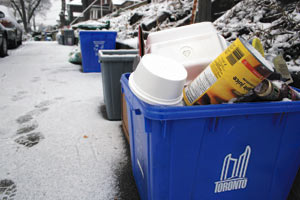Before drowning polar bears and egged Hummers, there was styrofoam. Get ready, kids – the symbol of disposable consumption that spawned a mighty backlash back when Big Macs were still wrapped in the stuff might be the target of a new packaging uprising. Could the shuttering of Canada’s only styro recycling plant kick-start it all?
The new year did not commence well for Canadian recycling, especially right here in Toronto. In late December, 10 months before the city was poised to start adding polystyrene, aka styrofoam, as well as plastic bags to its blue bins, Canada’s only dedicated styrofoam recycler sent out a closure notice, effective immediately.
Odd, considering that the Malton plant had just been outfitted with $300,000 worth of new equipment to meet Toronto’s incoming load. But the Canadian Polystyrene Recycling Association (CPRA), the industry group that started recycling styrofoam for other towns in 1991, says the plant was a victim of bad timing. The skyrocketing Canadian dollar meant a 30 per cent dive in export revenue from end-use markets (like plant trays and CD cases) in the U.S. But more importantly, CPRA says the plant just hasn’t been getting enough raw material to keep its doors open any longer.
Disappointing? Yes. But surprising? Not to Jo-Anne St. Godard of the Recycling Council of Ontario. “The whole polystyrene marketplace has been extremely volatile at best,” she says.
Most municipalities had little interest in collecting the food-smeared foam that litters streets with every gust of wind (hence Toronto’s new roughly $5-mil-a-year lidded bin design). Some, like Ottawa, which cancelled polystyrene and other plastic recycling in 2004, complained there just isn’t a market for it.
“Lots of municipalities had given it a go and been unsuccessful, and there’s a reason for that,” says Godard. Hell, the supply issue has led to the shuttering of four similar U.S. recycling plants in the past 10 years.
Roman Talkowski, chair of CPRA, doesn’t blame styro-shy municipalities for the shortfall in supply, though he insists the market for recycled polystyrene is growing by 14 per cent a year. The problem, he says, is that the plant has essentially been stranded by the province.
“When the Ontario government put the blue box program into effect, it only mandated that municipalities have to recycle PET and HDPE [two types of plastic].” Polystyrene recycling, he says, needs to be added to that list.
![]()
But the question on more and more lips, even if the plant makes a comeback under new owners (which Toronto hopes will be the case), is whether more recycling is really the answer. After 26 years of the blue box, we might finally be ready move past the bottom rung of the three Rs.
Over 5,000 Torontonians have signed a petition pressing officials here to link arms with nearly 20 American jurisdictions to straight-up ban the takeout plastic from restaurants and cafés. NaturoPack, the not-for-profit group behind the petition, hopes to bring its list of signatures to council by the end of the month.
“We want to get things moving now that the plant has closed and there’s no other feasible option for recycling styrofoam waste,” says NaturoPack’s Farrah Khan.
And city officials seem poised to listen. In fact, a six-month-old packaging working group filled with council’s enviro heavy hitters is looking into flexing the new City Of Toronto Act and taking direct action against in-store packaging – namely disposable vessels filled onsite within city limits, including coffee cups, takeout containers, meat trays, clamshells, even plastic bags.
The group is weighing a whole range of options, says the city’s solid waste GM, Geoff Rathbone, “all the way from voluntary measures through levies or fees, as well as bans and even local deposit return systems.”
Bans, wunderbar, but voluntary measures have never inspired much confidence in the enviro world.
![]()
Even if a welcome series of bans and levies goes ahead, the city will be stuck with all the styrofoam packed outside T.O.’s perimeters. (Seventy per cent of all packaging happens outside our borders.) For that, fingers point to Queen’s Park.
For its part, the province is spearheading a stakeholder meeting with the Canadian Council of Ministers of the Environment on packaging reduction next month. Long-time-waste-activist-turned-city-councillor Gord Perks finds optimism tough.
“I spent 20 years attempting to get the province of Ontario to take waste management seriously, and I’m still waiting for action.”
The only reason we wind up at these inter-provincial meetings, says Perks, is because the major industries say they don’t want to have to deal with varying regs in each province. “But what’s really going on is that they know there is no program PEI, Quebec and Alberta can all agree on, so they very cheerfully go off to these discussions, knowing full well that nothing will happen.”
Ministry spokesperson John Steele counters, “If that’s the case, then why were these meetings successful between the late 80s and mid-90s, with about a 50 per cent reduction in packaging sent for disposal?”
Nonetheless, Maureen Carter-Whitney, research director at the Canadian Institute for Environmental Law and Policy, who has a seat at the table, concedes that with so many different interests involved, “things do end up getting watered down because you’re trying to find a compromise.”
But with corporate stakeholders like Wal-Mart now forcing big-name suppliers like Procter & Gamble to cut back on packaging or else, Carter-Whitney hopes the timing for consensus on this is right.
Wanna be sure more big businesses jump on board? Do as the Europeans do and leave your bulky packaging with retailers – whether they want it or not. Oh, and send some to your local MPP while you’re at it.

